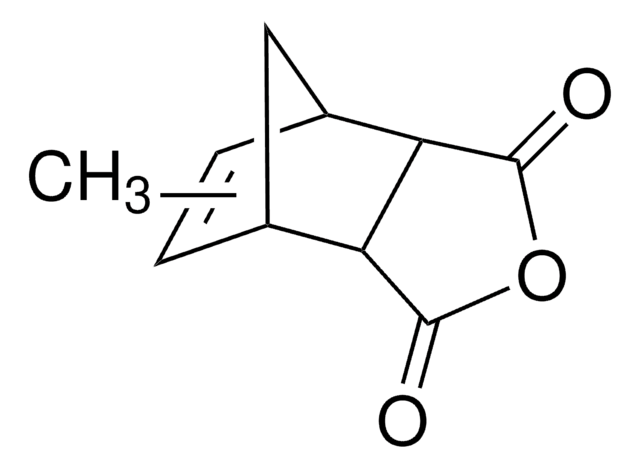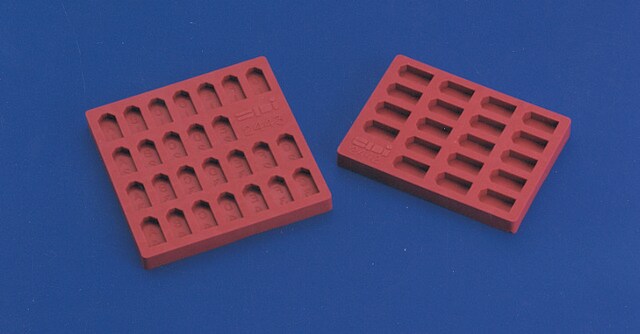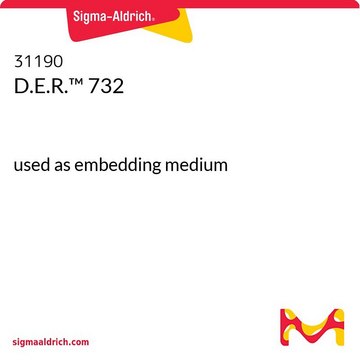EM0300
Spurr Low Viscosity Embedding Kit
hydrophobic resin for embedding histological samples
Sinónimos:
resin for specimen preparation
Iniciar sesiónpara Ver la Fijación de precios por contrato y de la organización
About This Item
Código UNSPSC:
12171500
NACRES:
NA.47
Productos recomendados
Descripción general
Spurr resin is a hydrophobic resin. It is less viscous than epon mixtures and is easier to dispense. The low viscosity of the resin contributes to its penetration in tissue, mineral and dense structures. A low viscosity of 60 cps also allows easy penetration into a variety of difficult materials.
Aplicación
Exceptional penetration for tissue, mineral, and dense structures. A low viscosity of 60 cps allows easy penetration into a variety of difficult materials. Spurr low viscosity embedding kit has been used to embed histological samples like tissues, organs and embryos. It may be used to prepare mineral specimens for polishing. The low viscosity of the Spurr formulation allows rapid infiltration into tissues, minerals, and other dense structures.
Solo componentes del kit
Referencia del producto
Descripción
- Nonenylsuccinic anhydride 450 g
- D.E.R. 736 250 g
- Dimethylaminoethanol 100 g
- ERL 4221 250 g
Palabra de señalización
Danger
Frases de peligro
Clasificaciones de peligro
Acute Tox. 3 Inhalation - Acute Tox. 4 Dermal - Acute Tox. 4 Oral - Eye Dam. 1 - Flam. Liq. 3 - Muta. 2 - Skin Corr. 1B - STOT SE 3
Órganos de actuación
Respiratory system
Código de clase de almacenamiento
3 - Flammable liquids
Punto de inflamabilidad (°F)
102.2 °F
Punto de inflamabilidad (°C)
39 °C
Certificados de análisis (COA)
Busque Certificados de análisis (COA) introduciendo el número de lote del producto. Los números de lote se encuentran en la etiqueta del producto después de las palabras «Lot» o «Batch»
¿Ya tiene este producto?
Encuentre la documentación para los productos que ha comprado recientemente en la Biblioteca de documentos.
Los clientes también vieron
Frederick J Warren et al.
The Plant journal : for cell and molecular biology, 84(3), 634-646 (2015-09-25)
Infrared microspectroscopy is a tool with potential for studies of the microstructure, chemical composition and functionality of plants at a subcellular level. Here we present the use of high-resolution bench top-based infrared microspectroscopy to investigate the microstructure of Triticum aestivum L.
Gergely Hegyi et al.
The Journal of experimental biology, 221(Pt 9) (2018-04-05)
Structural plumage colour is one of the most enigmatic sexually selected traits. The information content of structural colour variation is debated, and the heterogeneity of the findings is hard to explain because the proximate background of within-species colour differences is
A routine method for embedding animal tissues in Spurr resin for electron microscopy.
Wallis M A and R L Griffin
Journal of Clinical Pathology, 26(1), 77-77 (1973)
Samir Dekali et al.
Toxicology, 365, 1-8 (2016-08-01)
DWCNTs have numerous industrial and biomedical applications and several studies reported that they could act as immunomodulator systems. The immune system is the first line of defence of the human body when exposed to particulate matter. In order to investigate
Sara Abolhassani Rad et al.
Plant signaling & behavior, 13(10), e1517075-e1517075 (2018-09-27)
AROGENATE DEHAYDRATASE2 (ADT2) is a member of the Arabidopsis thaliana ADT family. All members of this family act as arogenate dehydratases in phenylalanine biosynthesis, decarboxylating/dehydrating arogenate to phenylalanine. ADT2 is detected in stromules, and as a ring around the equatorial
Nuestro equipo de científicos tiene experiencia en todas las áreas de investigación: Ciencias de la vida, Ciencia de los materiales, Síntesis química, Cromatografía, Analítica y muchas otras.
Póngase en contacto con el Servicio técnico











